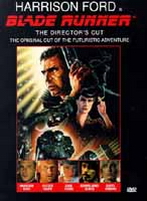| |
|
|
|
|
|
| |
1. |
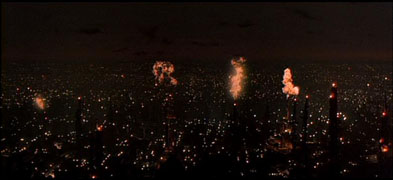 |
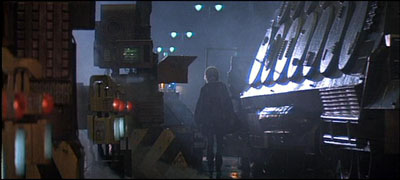 |
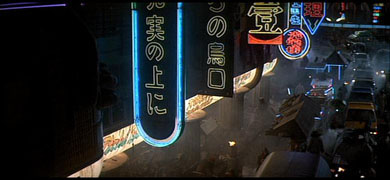 |
|
| |
Adam Brady
Comment on the environmental state of L.A. in 2019? How does the
state of the environment in this film contribute or not to a sense of
the uncanny? Does this change the impact of this film in comparison with
the others we have viewed thus far this term?
Blade Runner depicts the 21th century as very bleak and despairing.
The city appears to be floundering within a state or dystopia. Los
Angeles – as we only are told this at the beginning of the film – is
essentially an urban wasteland. The only visible is that of flames
and artificial light; the city is in complete darkness. The city’s
canopy is dark and thick. The pollution in Los Angeles is so terrible
that no natural light is strong enough to pierce its dense shroud.
One of the underlying reasons for the city’s uniformity in distributed
filth; is that there appears to be no delineation between different
areas within the city, there are no boundaries between the residential,
commercial and industrial zones. In Rintaro’s Metropolis the
city is divided into a hierarchy of zones, through economic and technological
differences. By constantly building upwards upon the trash, a beautiful,
spotless city exists above the surface, make Metropolis more appealing
to the eye of the world. In Scott’s Los Angeles, the different
zones spilling into one another cause a switch in hierarchy, leaving
the city in shambles. No other city is referenced within the film,
nor it the city ever referenced as being Los Angeles by any characters
or signage. Only Earth’s off-world colonies are ever mentioned,
allowing the mind to inquest into of the state of being of the rest
of the world. Could it to be in this state of disarray and despair?
Because of this amalgamation of zones within the city limits, and
no visible view any of Los Angeles’ known landmarks, there arises
this feeling of the uncanny, where the audience cannot identify themselves
in Los Angeles only thirty years into the future. In the entirety of
the film, there is rarely any signage visible written in English (note
the third still image) with the exception of large global organisation
such as TDK, Coca-Cola and Budweiser. It becomes ever more difficult
for the audience relate to the city. The film setting(s) try endlessly
to shroud the city is confusion and shadow, creating a vision of the
uncanny. |
|
| |
2.
|
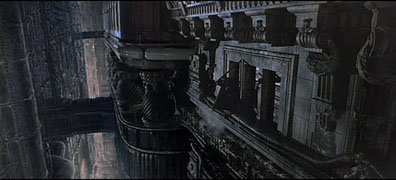 |
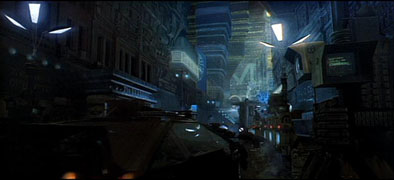 |
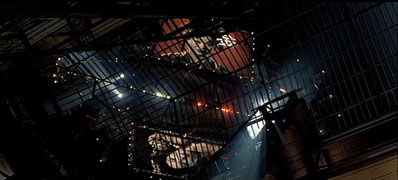 |
|
| |
Cassandra Cautius
Comment on the technique of blending existing streetscapes with animated/model
environments? How does this impact the creation of an uncanny urban environment?
How does this extend the repetoire of techniques that we have looked
at thus far? (go easy on reference to the Bradbury Building as it
is the specific topic next question down).
In Ridley Scott’s Blade Runner all scenes appear to be set in
a dark and damp environment, the entire movie is dark, literally and
thematically. The film set in a dystopian Los Angeles of the not so distant
future. The urban landscapes (clearly derived from dense urban metropolises
with bright lights and invasive advertising like that of Hong Kong or
Tokyo) are a credible picture of a high tech future. Visions of industrial
nighttime landscapes are always painted dark and oppressive often including
steam from sewers to stimulate the other senses towards the probability
that this is a cold, unhealthy, sticky and possibly smelly environment.
The ground level streetscapes recall the sub levels of Lang’s metropolis
on a far greater scale. In fact it would appear that many stylistic mood
choices of the film were derived from Lang’s Metropolis. In the
film it would appear as though most shots of existing streetscapes are
taken from above in order to keep in check the vast height of the city
depicted. In this way it does appear to reflect the sub zones although
the streets are still considered grade. I personally always find
myself instilled with a strong sense of the uncanny at the complete absence
of natural life in a futuristic depiction. The lack of any natural world
with which to identify leaves a feeling of despair and a high level of
tension between the past, present and future in general. The invasive
advertising almost feels comforting in this society as it is something
we can relate to and find reference to normality of life whereas the
last of nature leaves questions of our environment’s future, in
a place where personal pets are genetically engineered this then leads
to questions of humanity and morality. This film portrays society at
a sophisticated level of technology and engineering and many of the settings
are high tech and gleaming, shining hope, but all of this is juxtaposed
with rot and decay of existing buildings. It is a retrofitted future
in which Urban artifacts of our current time (like the Bradbury building
to Los Angeles) are still included in the future. No society destroys
their own greatest works. But leave them intact as a testament to the
future. These artifacts obtain monumentality but as apparent in the film
the new pushes past the old, and hence the old is brought into decay
and left to the dredges of time, particularly in a world where growth
is directed upwards and the limits of the past are left in the past.
|
|
| |
3. |
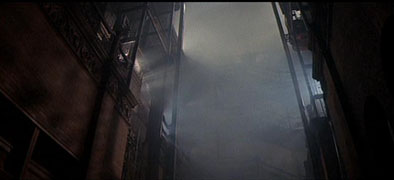 |
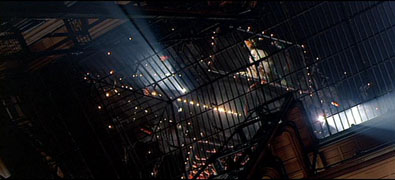 |
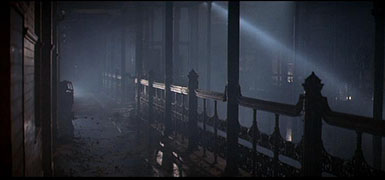 |
|
| |
Alexander Chan
Talk abou the transformation of the interior of the Bradbury Building?
More or less effective than a completely artificial environment? How
does the adaptation of a real building (that many people might actually
recognize) alter the success of the uncanny in this part of the film?
The interior of the building is completely different from its present
state in reality. The real Bradley Building is a pristine 19th century
building that has exuberant skylights letting in gracious amounts of
daylight with intricate metal detailing all over it. It is quite a lovely
building. However in Blade Runner, it has become an abandoned building
in disrepair inhabited by an asocial android designer.
The set embodies Blade Runner. The urban landscape that Ripley created
is embodied within the Bradley Building. There is very little differentiation
between the interior and exterior. Certain corridors are visually similar
to dirty streets with debris, trash and puddles all over the place. Additionally
with all the fog and mist the building, the spaces seems to slip in and
out with very little sense of definition and barrier. There is definitely
a sense of mystery to the ephemeral surroundings that hides things in
the distance. The darkness also flattens everything and encompasses everything
around it.
The fact that the set was not completely fabricated helps anchor Blade
Runner into our historical continuity suggesting that it could be a possibility
in the future. This of course aids the overall uncanny aspects of the
film. However the fact that people might actually experience the space
before watching Blade Runner could add a tactile sense/quality to the
film that would be impossible without a physical construct in reality.
This adds a very personal quality to the film that might bring unease
to some.
I believe that Blade Runner’s environments are all beyond human
scale and that the Bradley Building was the only reminiscence of this
organizational and proportional system. It helps add to the realism of
the film because it offers something the audience can relate to and interpret.
It also addresses the Blade Runner aesthetic as an assimilative one that
could amalgamate with anything.
An argument could be made that the Bradley Building was in fact a topological
interpretation of Sebastian’s character and that Sebastian, a product
of the era Blade Runner, is actually part of a collective influence that
modifies the environmental around him. This could suggest that uncanny
architecture or architecture adopting uncanny aspects is actually the
accumulated influence of the collective consciousness or an individual.
|
|
| x |
4. |
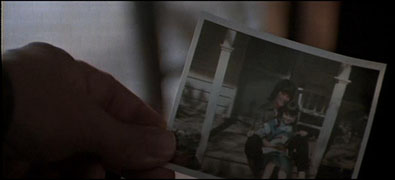 |
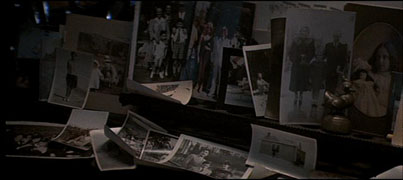 |
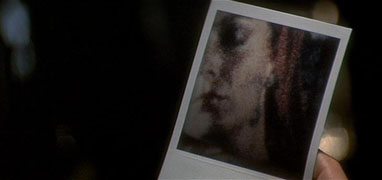 |
x |
| |
David Henderson
Speak about the significance of photographs in the film? How do these
play into notions of false memories and perhaps some surrealist notions
of dreams and altered states of belief or being? How might the presence
of these in Deckard's apartment be simultaneously seen to support the
"homely" and the "uncanny"?
Photographs capture a moment in time and freeze that instant, but in
this movie they are used to enforce falsities rather than preserving
a moment in time. Despite the fictional nature - of which some of the
replicants are unaware - of their memories, they perceive these “false
memories” emplanted within them to be real. Memories exist purely
in our minds, and photographs merely remind us of them. There is little
difference between a memory of an actual event and a memory of something
that didn’t take place. A memory of a dream may be recognized as
such, but you remember it the same way you would remember any waking
experience. There is of course a distinction between memories and fabricated
memories in regards to the actual physical happening of the event, but
after the event is over, there is nothing left but the memory, making
a memory of the physical event just as real as a memory of the fictional
event.
In Deckard’s
apartment, there are a lot of photos of what seem to be friends and family,
yet there is never any physical evidence of any of them ever existing other
than in the photos. Although there are many possible, simple explanations for
this, it raises the question of Deckard’s state of being and if, in fact,
he is human. Photos are a common item to find in a home, which makes his apartment
feel more comfortable but at the same time, the idea of false memories is very
prevalent in the movie and seeing the abundance of photos immediately makes
you question their validity. The state in which he keeps his photographs is
also something to note. Most people put photos in frames or pin them on walls
so they can always see them, but Deckard’s are strewn across the desk
showing that little care has been put in to keeping the photos safe and intact.
If the photographs were of people that he loves or loved, he would not treat
them so carelessly especially since these people seem to be no longer present
in his life. The way he keeps these photos points towards how he may be holding
on to these “memories” not to remember people that he loves but
because these fabricated images are the only past he has. This uncertainty
as to whether or not Deckard’s memories are real or fabricated and thusly
whether or not he is a human or replicant creates a very uncanny feeling. Even
the term “replicant” brings up this feeling as replicant implies
something that appears to be real but in actuality is not. What this movie
brings to light is that reality is not defined by the physical realm, but by
perception.
|
|
| |
5. |
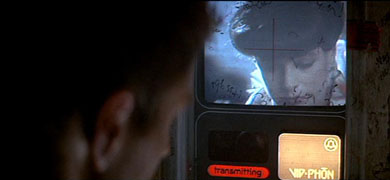 |
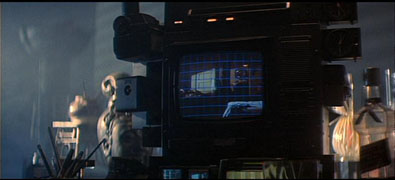 |
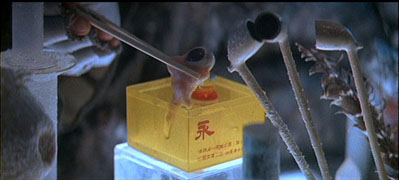 |
|
| |
Minwoo Lee
Talk about the state of technological gadgets in 2019? How does this
compare with the technologies presented in Metropolis 1927 and 2001?
Given the date of the film being 1982, do you think Ridley Scott went
far enough with these? Do you feel they were more uncanny then than they
are now, or vice versa?
The portrayal of technological advances in Blade
Runner is characterized by the strong correlation between technology
and everyday life. Ridley Scott meticulously constructs visions of
technological advancement through objects of varying scales, from large
buildings to small gadgets. This particular attention to detail heightens
the sense of realism that allows the audience to relate more strongly
with the environment created in the movie.
The
director emphasizes the visual impact of the visionary world by intermingling
futuristic technology with objects of everyday life. Like in Tezuka’s
Metropolis, this interplay of contemporary and futuristic elements
creates an ambiguity in the movie’s chronological setting. This
ambiguity creates a notion that the society in Bladerunner is plausible
and a realizable dream. This interplay also gives a tactile quality
to the movie by associating the qualities of appliances that are contemporary
to the audience to the gadgets of the future as portrayed in the movie.
This
method in which technology is depicted in Bladerunner is
distinct in comparison to Fritz Lang’s Metropolis. The
focus in which technology is depicted in Bladerunner, through
the use of gadgets, is to endow realism to the futuristic vision of
the movie, however, in Metropolis, technology is used in symbolic
terms that do not associate with activities of everyday life. Consequently,
Metropolis lacks
the sense of believability that renders itself as a mere fantasy..
The
efforts by Ridley Scott in trying to convey a believable vision of the
future also created dilemma in sufficing for the incomplete view of the
future. The actual world of the future would hold no likeness to our
own, thus in trying to create a complete vision of the future, there
would be a complete disjunction between the audience and the movie. In
his attempt to create a more believable and tactile visuals, the Ridley
Scott sacrificed the true vision of the future that he wanted portray
by finding the middle ground through the mediums of gadgets. However,
it is this emphasis on realism that creates a strong sense of uncanny
in the audience by exploiting the idea that a world of Bladerunner may
one day become our own.
|
|
| |
6. |
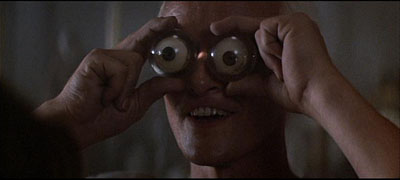 |
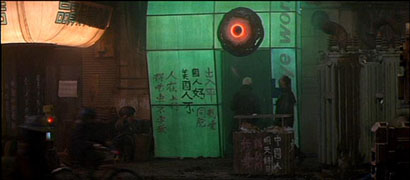 |
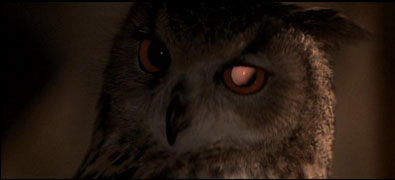 |
|
| |
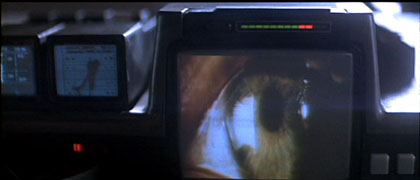 |
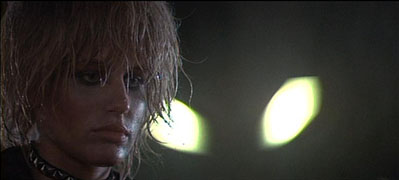 |
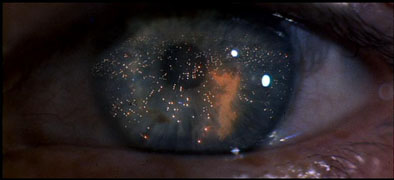 |
|
| |
Paula Lee
Significance of Eyes? How does the presenation of eyes in this film
compare with the others we have seen? Does this feed into "the Uncanny
Valley" as pertains to android type beings?
In the film, Blade Runner, the director utilizes the eyes as a significant
symbol in bringing its viewers to ponder upon the main theme dealing
with complications between religion and moral implications concerning
the increasing human mastery of genetic engineering though technological
advancement. One of the very first scenes of the film is used to indicate
the relationship between the theme of religion and theosophy as viewers
see an eye which reflects the flames coming out from the chimneys of
the dark, industrialized city then on the next scene exposed to the Tyrell
building and then to a scene where the eyes reflecting both the flames
and the building which has a pyramid shape. The eyes in these scenes
represents an all-seeing eye, a freemasonic symbol representing the Great
Architect of the Universe that derives from an Egyptian symbol called
the eyes of Horus- the eye of the Egyptian god Osiris. In this sense,
the movie is shown in the perspective of God from its start. But
the eye appears to be damaged; full of spots and cataracts and even the
reflections do not seem to occur normally. Such might infer that we might
be watching the movie in the view of an artificial God, which then indicates
that the world viewed in the film is of artificial quality- lacking the
spirit of humanity in general. Another symbolism is the concept of memory
and its linkage to vision or the eyes. Rachael, a replicant, remembers
her childhood memories, in most cases involve visual information but
since her memories are implanted data, which make her memories fake,
then her character formed by memories and her behavior brought out by
her character, as well as her vision are all fake and deceptive. In other
films, such as Metropolis, the robots have eyes with dilated pupils,
those of which almost seems to have no living qualities or soul to them.
Similarly in Blade Runner, the replicants have eyes that are unreal as
they glow. The eyes are symbolic of soul and truth in some sense, as
we generally communicate more than seventy percent by eyes rather words; “ Look
at me in the eyes when you tell me the truth.” In this sense, the
robots in the film Metropolis and Blade Runner represents beings without
a true perception and or soul. The androids in the film relates to the
Uncanny Valley theory as they are so convincingly human yet lacking in
empathy that they are considered dangerous and banned on earth.
|
|
| |
7. |
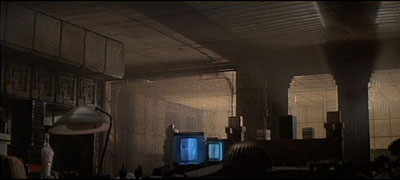 |
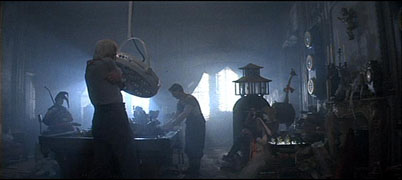 |
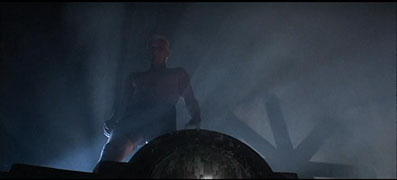 |
|
| |
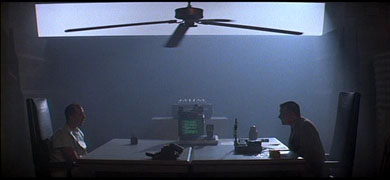 |
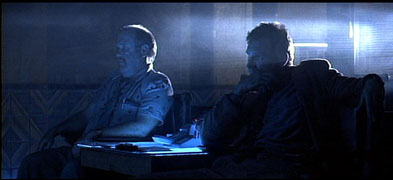 |
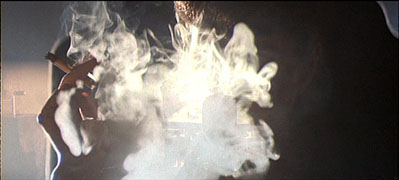 |
|
| |
Evelyn Lo
Source and effects of indirect lighting to illuminate most scenes?
How does the lighting in the film contribute to an atmosphere that might
be: dystopic? fearful? haunted? or uncanny?
Blade Runner incorporates various lighting techniques to create high
contrasts between light and shadow to determine what is exposed versus
hidden, and the dynamic movement of light and smoke to depict the futuristic
Los Angeles as a dystopic, haunted, uncomfortable city that is a result
of intense exploitation of technology leading to overpopulation, squalor
and immorality. Shafts of light were used throughout the film’s
interiors; particularly in Deckard’s apartment. The effect is darkened
interior spaces that would naturally create a sense of unease due to
obscurity. The spaces are revealed slowly and gradually through the beams
of light moving across and through them. This also means the viewers
are not given the opportunity to ever see the entire interior space illuminated
all at once, for as one area is revealed the last one sinks back into
darkness creating a strong sense of mystery and a fear of the unknown.
The concept behind these shafts of light was the idea that the entire
city was under perpetual surveillance by the authorities of the city
via airships that would float in the night emitting strong light beams
in rhythmic swinging lights similar to the searchlights of helicopters.
This implies a futuristic world that consists of stringent criminal enforcement
through authoritarian control and surveillance, to the extent of a severe
invasion of privacy. Shafts of lights were further intensified when the
concentration and density of smoke in the air increased. Thus, smoke
in the air has a two -fold purpose; to define the shafts of light and
to create an overall hazy, obscured environment. The unnatural intense
amount of smoke constantly swirling about in the air, is also reflective
of high levels of pollution of this dystopic futuristic city. To create
a high contrast between lighting effects, most scenes – particularly
those with actors in them, were harshly backlit with very subtle and
soft frontal uplighting. This then depicts the actors in silhouettes
that rarely reveal their facial expressions – giving each character
a sense of mystery, in that their thoughts and expressions are only minimally
revealed, making it difficult for viewers to determine their motives
and intentions. The lighting scheme in Blade Runner is highly theatrical
and is a major tool in creating a disturbing atmospheric condition to
accompany the plot of the film. The roaming shafts of light and the swirling
of the smoke illustrate the dynamic movement of light that is used to
create a disorienting and uncomfortable effect, while the intense light
and shadows contrasts is used by the moviemakers to be selective about
what is revealed versus what is concealed and left in obscurity to further
the unsettling, plot of the film.
Source:
http://www.theasc.com/magazine/mar99/blade/pg3.htm
|
|
| |
8. |
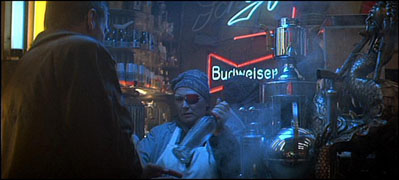 |
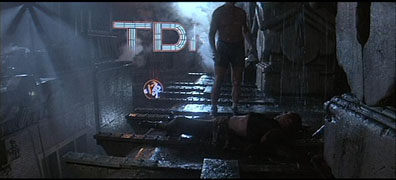 |
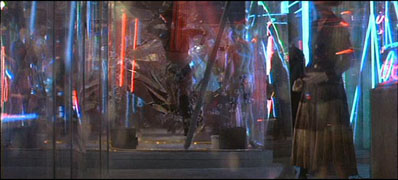 |
|
| |
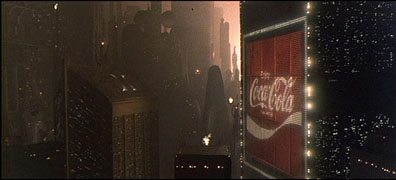 |
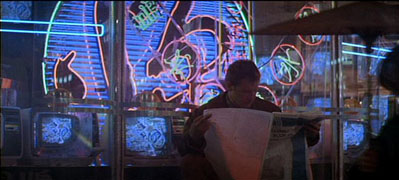 |
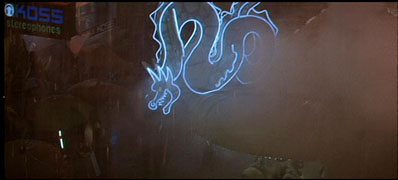 |
|
| |
John McFarlane
Use of neon/signage? How does this affect the life and environment
portrayed in the film? Does the neon AND advertising contribute in anyway
to supporting the portrayal of the uncanny?
The use of neon light in Blade Runner colors the environment of the
film while the use of neon and advertising contribute to a sense of unease
generated by the juxtaposition of the familiar image of advertising with
the dark, colored light of the sets. The colored light and information
density created by the signage are primary components in setting the
mood of the movie and fabricating the cyberpunk aesthetic read from Philip
K. Dick’s original story and seen in Ridley Scott’s influences:
The Long Tomorrow, illustrated by Moebius, and the magazine Métal
Hurlant.
Often neon lighting is the only visible lighting and the colored light
is the dominant color in the scene. The frequent use of the color blue,
for example, creates a cold and alienating environment where it is used,
in the grade-level scenes. During views of the larger city seen from
higher up, the lighting contains more colors and approximates natural
or incandescent light. These warmer colors of light, in contrast to the
blues of the lower levels, indicate the wealth and luxury and also decadence
and decline of the inhabitants of the upper levels, epitomized by Tyrell’s
fantastically luxurious apartments and his view of the setting sun far
above the city. The difference in lighting by social and literal height
and the movement between levels creates a feeling of unease, especially
descending into the depths and the hostile labyrinth of the surface streets.
The effect of the use of signage in the film is that an uncanny feeling
is created by the juxtaposition of familiar images presented in altered
contexts. The Budweiser logo sign, for example, is a recognizable image
nestled in the strangeness of the neo-Asian restaurant. The restaurant’s
blue dragon, a generalized image of restaurant signage, also has this
effect when viewed in the unfamiliar street environment. The image of
the Coca-Cola light display is itself usual, but becomes unusual when
applied at such a geologic scale. The low level of lighting from the
signs also generates a visual comparison to film noir, which was an influence
on the French illustrator Moebius’ (Jean Giraud) images for The
Long Tomorrow and Métal Hurlant, which were both strong visual
influences for director Ridley Scott and the initial concept work done
for Blade Runner.
The fact that the brands and logos are familiar also creates the effect
of information overload, wherein the backgrounds to the plot contain
recognizable fragments of information that compete with the plot for
the attention of the viewer. This saturation, combined with the futuristic
feel of the lighting and the commonness of the subject of the advertising
are used to construct the high-tech, low-life atmosphere of cyberpunk
culture.
|
|
| |
9. |
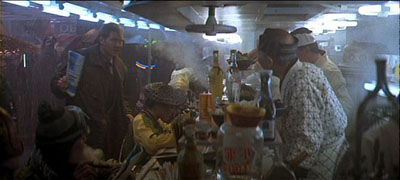 |
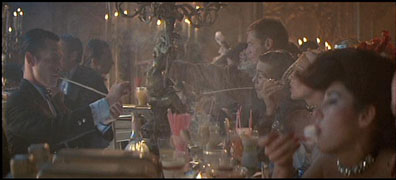 |
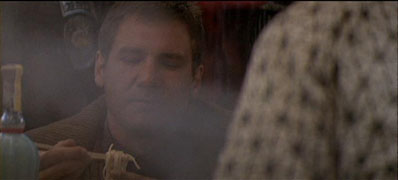 |
|
| |
Sava Miokovic
Concept of food and eating? There is far more attention paid to this
activity in this film as compared to the previous ones that we have looked
at. Why do you think this is so? How does it affect the portrayal of
both the plot and the reality of life in LA in 2019? Does it contribute
to either a feeling of comfort (homely) or discomfort (unhomely) in the
film, or can it be doing both?
In Blade Runner we are taken to a distant future world. The film
begins at the scale of the city. The audience is taken through
a series of shots of the massive and dense metropolis from above. This
is followed by a scene of Harrison Ford eating at a street vender. The
act of eating is used to zoom the audience in from the city scale to
the human scale. This occurs because eating is a very intimate
act we have all experienced many times. The atmosphere of the scene
is immediately transformed because our own memories are triggered. We
know what a steamy asian restaurant is like. We analyze what occurs
at a more intimate level in the context of a meal. Since dining
is a very social act, we give more attention to the particulars of human
interaction, the tone of voice, the expected reactions, and the consequent
feelings. Although, the reality of life in LA in 2019 seems very
different, distant and futuristic, eating makes it a very human world.
Eating also plays a role in the plot since we are constantly questioning,
following the thought process of the main character, which characters
are human and which are "non-human". The majority of
the audience immediately assumes that anyone who ingests organic matter
for sustenance must be human. Thus, later in the film, when we
observe "non-humans" eating and drinking, we have a greater
understanding of just how human these "non-humans" are.
I think the depiction of eating initially creates feelings of comfort
since it is much more familiar and comfortable then what is portrayed
in the scenes preceding it. However, this homely feeling is short
lived since the act occurs in a manner so different then the standard
family dinner, the reference case for the majority of the audience. All
the dining scenes in the film are chaotic, fast-paced, busy, and eclectic,
therefore making the dining experience unhomely.
|
|
| |
10. |
 |
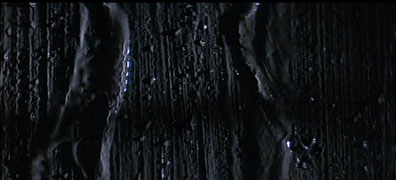 |
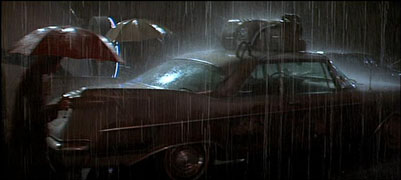 |
|
| |
Reena Mistry
Rain/water + darkness???? We see quite a different environment here
than in other films. How is it being used to increase the feeling of
unease or discomfort in this film? Would this film have the same impact
without the constant wetness?
The role of rain in Blade Runner is prominent in creating the atmosphere
of the industrial wasteland of the future Los Angeles. The constant downpour
is exemplary of the psychological and physical decay of this city and
provides the unsettling feeling of discomfort of the miserable, dark
setting.
Without the constant wetness, the film would have not had the same impact.
Darkness plays a very prominent role, and rain provides the final constant
element that enforces the discomfort and restlessness of the Blade Runner
environment. The incessant movement of people running through the dark,
wet streets gives an unsettling feeling – it creates a place that
is void of homeliness, shelter, comfort and rest. In conjunction with
the fire and smoke, rain and darkness enhance the density and dirtiness
of the city, obscuring visibility in the streets and making each character
seem as though they are constantly weeping. In hopes of running to a
warm place to hide from the dreary atmosphere, characters can only find
shelter in dark, cold interiors, often still dripping with the morbid
environment of outside. James Sebastian’s house is accessed by
a hallway complete with the puddles and constant leaks, barely lit by
the artificial light from outside. The interior of Eye Works takes discomfort
to the next extreme as the interior drips in subzero temperatures. Dark,
cold and dreary, the world in Blade Runner is void of any trace of warmth
or comfort; the city has no chance of feeling the elation of sunshine
producing the dystopia where there is no hope left.
Beyond the atmospheric effects of the ceaseless downpour,
an interesting reference to rain is made in the last words of Roy Batty, “All
those moments will be lost in time, like tears in rain.” Perhaps
rain is not simply an atmospheric component of the film, but also holds
a deeper meaning. On the other hand, when Ridley Scott was questioned
why he had the constant rain in his film, he responded, “because
you can't make a spinner fly without a crank. That's why it was raining
in the shot, to hide the cables."
|
|
| |
11. |
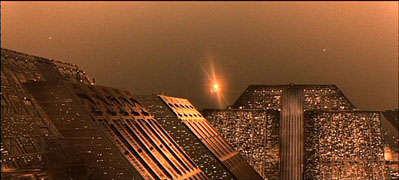 |
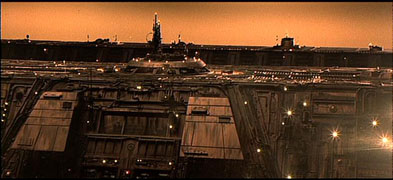 |
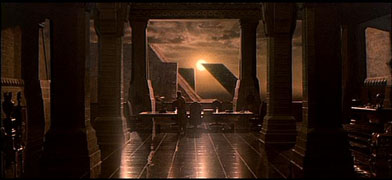 |
|
| |
Melissa Ng
The architecture of Tyrell Corporation's Headquarters?
Compare this to the type of architecture used in both versions of Metropolis.
Speculate upon the floor plan for these massive buildings? Issues like
distance from windows? What is it like to be "inside" these
buildings? Do you think this aspect of the reality of the buildings
proposed is lost on the general public? Do you think it really matters?
Do these buildings feed any ideas of the uncanny in the film?
The architecture of the Tyrell Corporation’s Headquarters in the
film, Blade Runner, is beyond human perception; the buildings are sublime,
inspiring awe absurdity. This future architecture is so immense
in scale that it no longer has the ability to relate to humans. Furthermore,
Blade runner and films such as Metropolis 1927 and Metropolis 2001, all
describe the ideal form of a skyscraper city in order to create a utopian
society.
In both versions of
Metropolis, the skyscrapers are so immense that they appear to grow on top
of other buildings. However, in Blade Runner, the architecture is of
such massive scale that it no longer has any distinguishable surrounding context – it
has literally besieged any buildings which may or may not be adjacent to it. The
scale of the architecture in each of these films – although almost indistinguishable – seems
to be relative to the era of which the film was created. For example,
Metropolis 1927’s skyscraper appears to be inspired by the scale and
drawings of Hugh Ferris’s vision of future New York City.
The floor plans of these
massive towers become unimaginable as the distance from the core of the building
to any form of natural light appear to be inconceivable due to its enormity
and depth. Along the perimeter of the buildings, one can imagine a space
which has idyllic views of the metropolitan landscape; however, beyond the
perimeter, one cannot imagine penetrating the eternal darkness of the core
within.
These buildings, so
intensive in its size, begin to lose the general public on its reality in one’s
present time. They surpass what is imaginable and become sublime to the
perceiver. While one often sees and perceives humans and society as a
reference scale within an urban metropolis, this architecture no longer is
able to capture the human scale; the skyscrapers have become so large that
people are no longer rendered in its depiction and shows that society is negligible
next to its greatness. This is significant as this architecture has a
resultant sentiment of fear; though one may understand that it is not a real
depiction of the world in one’s present day, one may also become afraid
of this depiction as a possible future.
This image of the future
world and its skyscrapers is able to invoke a feeling of sublime transcendence;
the architecture is magnificent and majestic, and yet at the same time, it
is also wild and savage.
|
|
| |
12. |
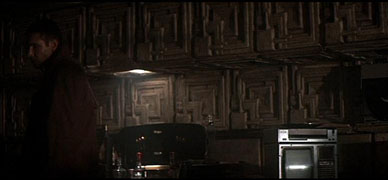 |
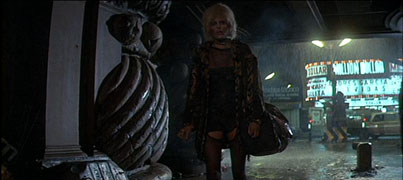 |
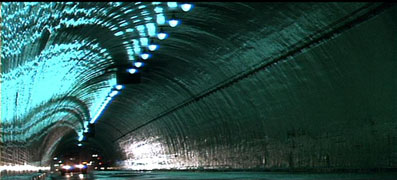 |
|
| |
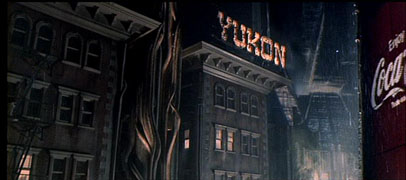 |
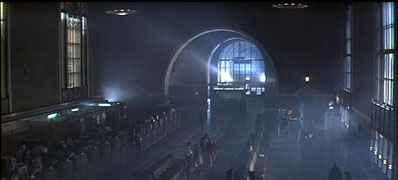 |
 |
|
| |
Aisling O'Carroll
Use of significant present day L.A. Buildings in an identifiable
form? How does this affect the believability or uncanniness of the
film?
Ridley Scott's film Blade Runner is set in a dystopic Los Angeles of
2019. While the existence in this location is still familiar as city
life, there are many new conditions placed on life in this setting. The
most prominent one is the existence of replicants; artificial humans
who are designed for off-planet combat and exploration. The existence
of artificial intelligence, as well as futuristic elements like flying
cars, etc, clearly put us somewhere in the future, in a new way of life,
strange to our own.
However,
while Scott creates this city-life of the future, he places it in downtown
LA, which for much of the movie is unrecognizable as itself, but there are
moments where prominent architecture is used to immediately place the viewer
back in a known context. By allowing the viewer moments of recognition, the
content of the film becomes even more disconcerting and uncanny because this
unbelievable, futuristic, frightening world is suddenly placeable in the world
around the viewer. The differentiation between reality and story becomes more
blurred, and the film has a stronger personal effect.
In one of
the early scenes, when Deckard is brought in to see Captain Harry Bryant, the
police station is set in the interior of Union Station. Union Station is the
hub of the commuter rail network in Los Angeles, and so is a very well known
and easily identifiable station. This transformation of site adds to the uncanniness
of the film because it suggests, in this dilaptidated version of Los Angles
in the future, the hubs for transportation in and out of the city are no longer
necessary, but the presence of large police force is now more important. This
change makes the audience even less comfortable with the surroundings they
observe.
A number
of historical buildings are presented in the building, for example Sebastian's
apartment which is inside an abandoned version of the Bradbury building, and
the interior of the Yukon Hotel where Leon stays is filmed inside the Irvine
Byrne building. These are the two oldest office buildings in Los Angeles, and
they are both depicted here as abandoned and rundown. Scott emphasizes here
the deterioration of society, where offices are being abandoned, left to corrode,
and are taken over by the weak characters in society - Sebastian, the lonely
toy maker, and the shady characters staying anonymously at the Yukon.
Outside
of Sebastian's apartment you can see the Million Dollar Theatre in the background.
This is one of the first movie theatres built in America, and it again enforces
the audiences grounding in the movies location, as it is infact located just
across the street from the Bradbury.
Taffy's
bar, which is where Deckard meets Zhora backstage, is filmed in the Wiltern
Theatre, a historic building and example of art deco architecture. This style
reflects the oppulance of the characters inhabiting it, and turns this site
for artistic shows into a dingy bar with an aura of an upper class establishment
and exotic dancing.
On the way
to Deckard's apartment he drives through the 2nd street tunnel, which is all
but empty at the time. This example existing Los Angeles infrastructure, which
is crucial to the current operation of the city, still exists in this future
world, but it seems empty, like the bones of an earlier city, in this shot
of Scott's. Deckard's apartment itself is set in Frank Lloyd Wright's, Ennis
Brown House. This house, built in 1924, was one of the first residences built
from concrete block, and while it is recognizable as an existing building in
the film, it still maintains a futuristic, decadent quality for the protagonists
house.
It is
interesting to note that all of these mentioned buildings that are referenced
in Scott's film, were all built in the early 19th century. Scott did not
just pick any buildings to reference in his film, but significantly old
buildings, many of whom have required restoration already. The Ennis Brown
House has been marked for structural instability since its construction.
The use of extremely old buildings makes Scott's scenario for future Los
Angeles not only more believable, but believable in a nearer future. Being
set in the future, it is easy to imagine a film an indefinite distance
away from the present, but when historical sites are depicted, and sites
with potential for ruin in the near future, suddenly the time being presented
is significantly closer to home.
|
|
| |
13. |
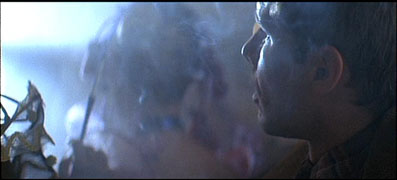 |
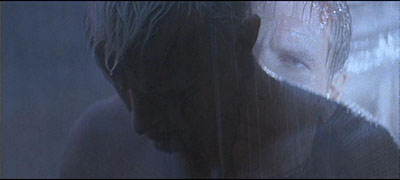 |
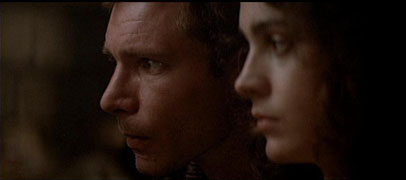 |
|
| |
Shannon Ross
Use of changing focus/depth of field? How does this change the ability
to create more subtle shifts of attention or increase detail in the film?
Compare this to earlier methods of creating specific facial focus that
we have seen.
The use of depth of field and change in focus allows the director to
convey or introduce characteristic dualities that help convey the theme
of the movie. The theme of the movie is mainly about the struggle
between the boundaries set by society on the classification of human
and non-human. The film asks us to consider what does it really
mean to be human and at what point do we differ from our creation.
The use of depth and change in focus is used in key frames to imply
the main character's struggle with these questions. For example,
the second image selected is of the main character and the protagonist
at the end of the movie when the main character realizes that his enemy
is embraces and accepts his death during his final moments. The
change in focus allows the viewer to be conscious of both facial expression
at once and creates a smoother transition between close-ups. The
blending of the shots also hints at the underlying theme that we are
not that different from our creations in terms of weathering in time
no matter how far removed we are from its actual biology.
The techniques used to increase detail in Blade Runner are conveyed
with the use of camera techniques while in Metropolis 1927 makeup techniques
are used to achieve the same effect. In Fritz Lang’s Metropolis
the real Maria is soothing and peaceful, her face is clear and easy to
read but the evil Maria is rendered with dark eyeliner, and more wild
expressions and movements.
|
|
| |
14. |
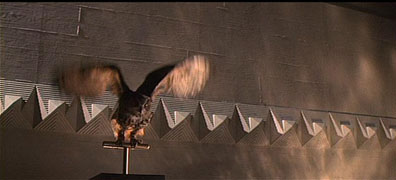 |
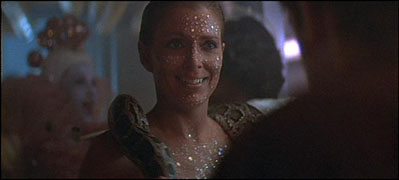 |
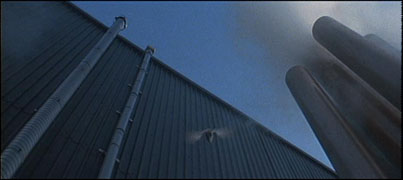 |
|
| |
Terry Sin
Reference to live animals? In the other futuristic films, the
roboticized elements were largely humanoid in nature - although there
are some inferences to animals in Metropolis 2001. How does this affect
both the plot and the presentation of the uncanny/uncanny valley in the
film?
In Blade Runner, all the animals present are robots or “replicants”.
In terms of the plot of the film, this element of mechanized animals,
or “animoids”, helps develop the state of the world in the
2019. In reference to the first image, Deckard asks Rachel if the owl
is real, to which she replies, “Of course it is”. She then
states that it is “very” expensive. In the next image, we
can see another synthetic animal, a python. It is possible to assume
that animals in 2019 are very rare and perhaps almost extinct. This could
be a result of environmental conditions and the general impact of humans
on nature. Scott’s depiction of LA involves no natural space and
is reminiscent of a giant landfill, with methane spewing from its towers.
Furthermore, introducing the owl early in the film allows us to understand
how deep genetic replication has reached. Using a real animal for filming
further enhances this effect. In the scene where Deckard has the snake
scale analyzed, the scale is seen at a microscopic level with a serial
number etched in the cells. While the animals are stated to be artificial,
it begins a discussion whether or not they are considered to be alive.
This develops an idea of the uncanny. While the animals appear to be
real, we are told they are artificial. At times, the eyes of the owls
have a reddish glow about them, but it is slight enough that we are unsure
if it is an effect or simply the lighting. It creates an unhomely feeling
of something that may seem familiar that is not as it is. At the end
of the movie we are not sure whether the dove is real or not. In every
other scene with animoids, they are seen in captivity with humans ensuring
that they do not lose their expensive hardware. However, at that point
of the movie it doesn’t seem matter, as the dove becomes more of
a symbol of freedom and peace. Yet in retrospect, it is uncanny be unsure
of such a simple element in a film.
|
|
| |
15. |
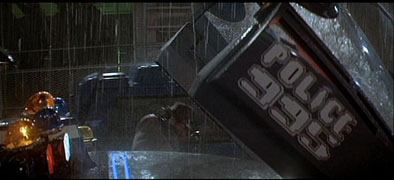 |
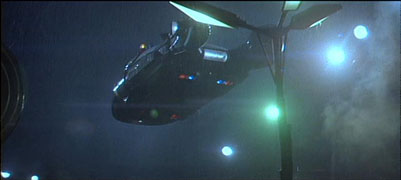 |
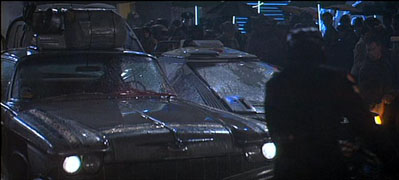 |
|
| |
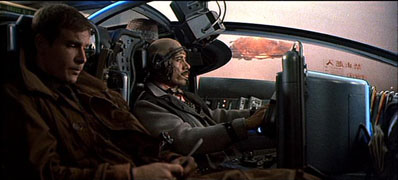 |
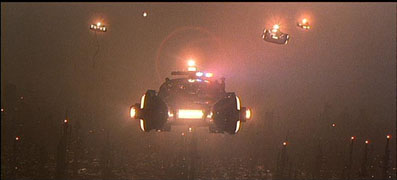 |
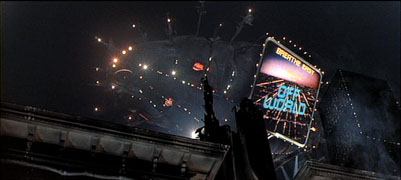 |
|
| |
Helen Tout
Change in Transportation? Compare Blade Runner to Metropolis 1927
and 2001 in this respect. Is the transportation presented in this film
more or less successful in creating a futuristic feeling? Do the
cars effectively relate to the cars of today?
In the 1927 film Metropolis the cars form large highways criss crossing
the cities net work. Transportation does not take part in the storyline
directly and is only shown in large views of the city to create a metropolitan
feel. In the 2001 version of Metropolis, transportation is also not a
big factor in the storyline and is only seen briefly. We mainly see the
main characters getting about on foot and the only transportation that
we see are the elevators between levels, and Duke Red’s car.
Transportation is prominent in Blade Runner. We see street cars that
look like modified older cars, police cars (the most modern looking cars),
and also advertising ships that seem completely alien to the cars that
we know. The characters in Blade Runner directly interact with the transportation
in this film as apposed to the Metropolis films; there are multiple scenes
in Blade Runner of characters in cars, around cars and looking at cars.
We are made more aware of the metropolis in this movie then the others
because we are looking at it in closer detail.
Syd Mead was hired by Ridley Scott to create the look of the Spinner.
He originally created renderings of experimental cars and products for
major corporations. Mead started designing the Spinner with the Blade
Runner world around it, including streetscapes and architecture. This
future world is not a utopia but a decrepit world that has gotten so
polluted that people are moving off planet to suburban colonies. He stated
that “everything had to look old, sleazy, and odd… a strange,
compacted, crowded look that exaggerates the danger and hopelessness
of these people’s lives.” (Webb, pg 45) Blade Runner
has a myriad of details in a very complex dystopic future. You can see
this throughout the film and also in the transportation. Although the
cars function differently (ie. doors that spring upwards, cars that move
vertically, dashboards full of strangely lit controls), they can still
be related to the cars today. They seem like renovated old cars. They
are all recognizable to us, but feel as if they’ve been modified
with the times because of necessity.
The transportation in Blade Runner gives a futuristic feeling. We can
relate to it which means that it has evolved from what we know, yet there
are still aspects that we don’t understand, meaning that it has
clearly evolved. For example, when Deckard goes to the inventors (Sebastian’s)
home he pulls up in what we can relate to as a relatively normal looking
car. But on the inside we see that the dashboard is very different, and
he contacts the house from a video phone device inside of his vehicle
which presents us with an entirely new kind of technology that we haven’t
seen before.
The police cars and off world advertising machines are the only apparent
flying vehicles in the film. They take off vertically which is strange
to us to see and certainly provides a futuristic feel.
Sources
Film Architecture: Set Designs from Metropolis to Blade Runner, edited
by Neumann, Dietrich, 1999, Prestel Verlag
Specifically pg 44-47, “Like Today, Only More So”;
The Credible Dystopia of Blade Runner, Webb, Michael
|
|
| |
16. |
 |
 |
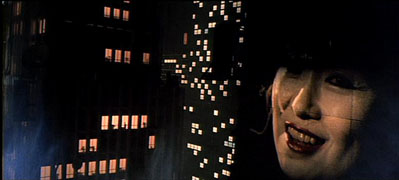 |
x |
| |
Jamie Usas
How does the potential of life in an
off world colony change the presentation of a dystopic future in
this film as compared to Metropolis 2001 or 1927? How does this
idea support the feelings of the uncanny as developed by the urban
nature of "life at grade" as depicted in the film. Drawing
into this discussion our talk about uncanny arising in urban spaces
either by beiing underpopulated or overpopulated. Layer on the
idea of almost perpetual darkness.
DO ANDROIDS DREAM OF OPPRESSIVE-URBANISM?
The three images above, taken from Ridley Scott's Blade Runner (based
on Philip K Dick's short story Do Androids Dream of Electric Sheep?),
depict a postmodern, dystopic metropolis that is the backdrop to the
film's narrative. The common element among the three images is
non-human entities suggesting that a better life is waiting in an "off
world colony", and, within the film, is expressed through the
medium of larger-than-life images, or more specifically, advertising. These
advertisements are positioned high above the citizens 'living at grade",
encouraging citizens to take “soma-esque” supplements
and migrate off world, taking the form of disembodied voices, heads
and torsos displayed on the high floors of sky scrapers and mounted
on the side of surveillance vehicles hovering above. The experience
of the urban "life at grade" is shrouded in literal darkness
and rain, creating the sense of timelessness, where each day bleeds
into the next without any clear distinction between day and night. The
uncanny arises when a citizen living "at grade" might wonder
when to sleep, or when to wake, without any sense of when today ends
and tomorrow begins. Conversely, the upper-class live high above
grade, in a state of perpetual sunset. This arguably suggests the ability
of the upper class to rise, while the life of those living "at
grade" remains static, and perpetual. This idea of dystopia
at "grade level" is unique to Blade Runner and
differs from the world presented in Metropolis 2001, where
the utopia exists “at grade" and all of the city’s
undesirable systems are positioned sub-terrainian, hidden from view. In Blade
Runner the upper class citizen can remove themselves from the
dystopia by building towers high above the ground level to live and
look down upon the dystopia below. However, the only true escape presented
in the film, is to exchange life on earth for life in an off world
colony.
Picture 1 captures the image of a geisha experiencing the ecstasy
evoked from ingesting a small red “soma-esque” pill. As
the viewer, we only experience the over-sized advertisement when flying
high above grade level in police vehicles, where the woman's image
appears to beckon the viewer to join her in a happiness appearing virtually
within reach. The viewer does not experience the image of the
geisha objectively, but as an observer rapidly rising off grade into
a higher and more utopic experience of the city. This contrasts
the Metropolis 2001 idea of utopic life at grade, which situates
all dystopic life below grade level.
Picture 2 depicts the image of an oppressive hovering vehicle that
displays advertisements for an off world colony, promising a better
life in a new world. The irony of this image is a product of
the pan-opt-iconic relation between the citizen "at grade",
who would have already left earth if they had the means or opportunity,
and the hovering, sparsely illuminated vehicle which appears to mock
at the citizens from above a glass ceiling.
Picture 3 frames the hovering vehicle displaying the geisha image,
this time from the point of view of the citizen at grade and framed
behind the iron bars of a fire escape, suggest the citizen "at
grade" is a prisoner to a society that dangles solutions from
just beyond reach, and forever elusive. The citizen remains trapped
in perpetual darkness, unable attain the quality of life elsewhere,
while constantly reminded of the poor quality of life citizens “at
grade” must endure.
|
|
| |
17. |
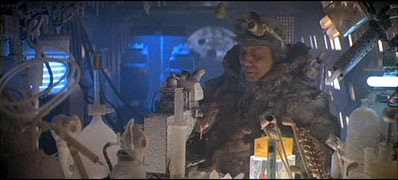 |
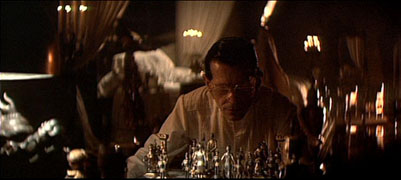 |
 |
|
| |
Susan Varickanickal
How does the role of these (mad) scientists
compare with those in the previous films? How do they feed into
any ideas of contributors to the uncanny valley? How do the varying
roles of the 3 inventors play into this discussion (noting that
in Caligari and Metropolis', each film only had one).
The (mad) scientists in the film Blade Runner were men who were part
of the mass production of androids. Their role was to create
super-robots with all the features and likeness of human beings in
order to perform specific tasks. This mass production of androids
differs from that of the previous films viewed involving the creation
of human-like robots. In comparison, the (mad) scientists’ roles
in the previous films were strictly focused on one specific product,
produced to carry out a specific task.
The scientists in the film Blade Runner can be seen as contributors
to the uncanny valley, due to their creation of robots with great similarities
(both physical and emotional) to that of a human being. Since
the androids were created with a shelf-life of only four years they
can be regarded as merely tools to further human existence, yet they
are created with memories from a past which did not exist to them. The
newest generation of androids were created in such a likeness as humans
that they began to long for the same quality of life and existence.
There now is a difficulty in separating the likeness of emotions and
sincerity of the androids to that of a human being. This confusion
leads to the feeling of “strangeness” in the human observer.
The creator of the Androids, Tyrell, embraced the existence of the
androids, which ultimately lead to his own death. In the end
he embraced them as a significant species and therefore blurring even
more the line which separates humans as a supreme being over robots. The
scientist with the aging disorder, who was responsible for the genetic
design of some of the androids, admired the androids. The android
had qualities which made them look more normal than he ever could. This
also leaves the human viewer with feeling of strangeness. The
scientist responsible for the manufacturing of the eyes of the androids,
created the eyes in such human-like form, yet the eyes were the key
to identifying the androids to the humans. Again the uncanny
similarities between the android and the human leave the human viewer
with uneasy feelings towards the androids.
|
|
| |
18. |
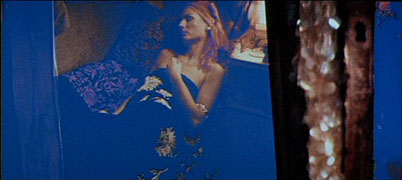 |
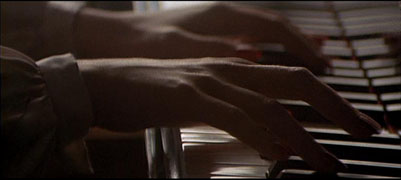 |
 |
|
| |
Chao Lun Wang
Posture on the role
of "art" and
artistic expression as proposed in 2019. What IS art? Does it
still have a role or purpose? If so, what is that? Are there any
aspects of art that contribute to the uncanny in the film? Does
some of it make you feel more or less at home with spaces and
actions as a result of its position in the film?
In 2019 Los Angeles, the role of art and artistic expression has been
reduced to the purpose of a resort for people to escape from their inhumane
lives.
The first image depicts Zorah, the replicant who lives on earth as a
dancer/performer. Her training as an assassin and the fact that she performs
with snakes probably suggests that her performance would be quite dazzling,
like the shows at Crazy Horse in Paris. However her status is never regarded
as an artist. Rather, she’s been exploited by her audience and
her boss as a sexual object.
In the second image, Rick is sitting in front of a piano in a solitary
mood and pressed on the keys but was unable to play a piece of composed
music. The notes alone offers a sense of serenity that puts Rick to sleep.
He is not interested in the architecture of a piece of music, rather,
he seeks salvation in the nature of an harmonious sound that is latent
in 2019.
In the last image, a comical android created by Sebastian greets his
guests. This android has an artificial intelligence but was intentionally
kept low to represent the naivety of a child. Sebastian created this
puppet android with a Pinocchio nose to keep himself company in a society
where friendship is a rarity. However the android could not develop any
emotion towards Sebastian and only operates in its programmed realm.
There are several scenes where art contribute to a sense of uncanny
in the film. One is when the blimp balloon penetrates every street corner
with harsh spot light. Even a structure as massive as the Bradbury building
can not escape from the light, giving a sense of everyone is being watched
wherever they are. Moreover, the odd Japanese advertisements that light
up entire city blocks also contribute to the uncanny be putting the audience
in the most unnatural landscape. Finally the origami unicorn left by
Gaff is very uncanny because it shows that Gaff knows about Rick’s
dream. This not only shows that Gaff has been watching Rick through out
the development of the plot, but it also questions Rick’s true
identity as a human, since his mind can be read.
The three scenes involving art somewhat makes me
feel more at home than the rest of the film because they are ways in which
people in 2019 deals with solitude. Though, the environment and technology
of 2019 is unrecognizable, but the fear for solitude remains the same,
as though the human emotions did not evolve at the same pace. |
|
| |
19. |
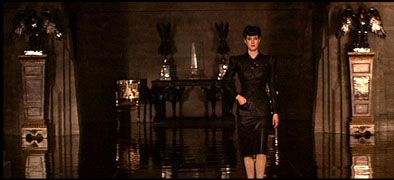 |
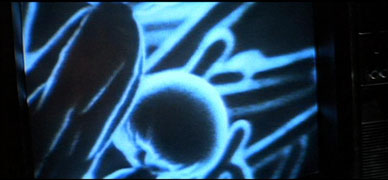 |
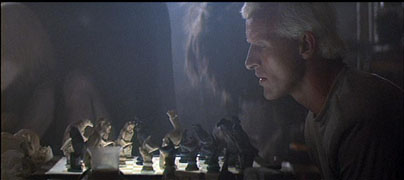 |
|
| |
Benjamin Wong
How is the role of "perfection" in
human beings translated into a similar presentation of architecture
and architectural expression in the urban and architectural environment
of 2019?
In Blade Runner, the replicants are described as the perfect beings. Their
physical and intellectual capabilities supposedly surpass those of any
human, with the exception of the ability to feel. Even their emotions,
however, are able to eventually develop after four years. In a
sense, the replicants are more human than human. They have more
empathy than their creators and those who hunt them down to “retire” them.
The three images depict three examples of replicants in the movie. The
first image is the movie’s introduction to the character of Rachel,
who is a replicant created without the cognisance of her own inhuman
condition. The scenes introducing Rachel’s character shows
how close she is to absolute perfection in terms of imitating humans
through her perfect composure and appearance. The second image
is showing the cells of the replicant snake skin, which was created identical
to a real snake, except for the markings that differentiate it from the
authentic. In the last image is Roy, who within a few moments has
figured out how to defeat Tyrell in the chess game with Sebastian. Roy’s
intelligence is superior to that of even Tyrell, a supposed genius among
the human race.
The Nexus 6 replicants, however, are destined to live only shortly. They
are either “retired” or eventually die after the four years
of life programmed into their system. This is the horror that each
of the replicants must deal with. They must also come to terms
with an internal struggle, to accept themselves for who they are. Even
with their superhuman capabilities, they are also considered expendable
pawns. This is the reason for their internal psychological decay.
This idea is comparable to that of the architecture of the city of LA
in 2019 depicted in the film. The future world shown is one of
decay. Within all the glory of the technological advancements,
lies a decrepit realm of despair. In this future, technology has
not brought on any great life of convenience. The issues of crime,
litter, and global warming have only been multiplied to a terrifying
extent. The inability to feel inherent in a replicant’s programming
is mirrored in the lack of empathy among the people of this society. This
world seems to be so blindly driven only for the purpose of commerce
that there has developed a dehumanization and deterioration of morals. This
is evident in the Japanese advertisements covering all the buildings. Furthermore,
the Off-World Colony and the building Sebastian lives in shows how abandonment
of these areas of excessive decay becomes the natural reaction of a society’s
mass consumption.
|
|
| |
20. |
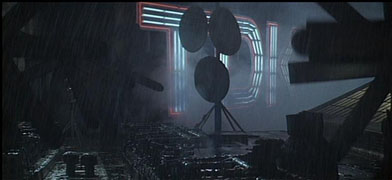 |
 |
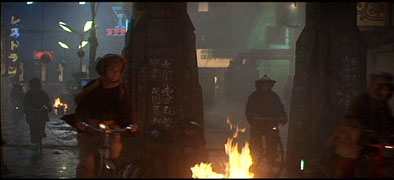 |
|
| |
Erin Corcoran
Comment on the use of decay in buildings
as it relates to the plot, setting and significance of the associated
parts of the films. Does this support the idea of the unhomely?
Would these environments be any more or less unhomely today or
in 1982? Does the timeframe make a difference?
Set in the not-too-distant future and released in 1982, Blade runner
is admitted into the collective conscious just as the world is making
its way out of the prosperity and hope of the 50s and 60s, the disillusionment
of the 70s and as it begins to develop the apathetic attitudes of the
1980s. The film is set in a futuristic city of towering monoliths and
bright advertised off-world paradises, where old and new are hashed
together in a dark twisted combination of rotting misshapen history
and oppressive rusting infrastructure. Within this mix, it is the decaying
elements that speak most to the theme within the film of a brilliant
future gone to seed, of past dreams now forgotten or ignored. The story
revolves around the creation of 'more human than human' replicants
(androids), whose perfect design fails to completely hide the disastrous
moral complications inherent in their creation. They are a microcosm
for the ideal of the entire world, where design (building higher and
higher, faster and better), has failed to take into account the human
scale, creating instead, industrial wastelands of grit, fire and darkness.
Within the above scenes, this backdrop of ignored decay is brought
to the spotlight, forcing the characters to recognize their environments
just as they are confronted with the difficult questions posed by the
creation of false-humans.
Within the first two images, bright advertisements offering solutions
for the future provide the only light over a wasteland of obsolete
machines atop a crumbling abandoned building. It is here that Deckard
is forced to come to grips with the scheduled obsolescence of his adversary,
the replicant, as it gives up its murderous chase to offer its last
words before 'dying'. A human being in all ways but its birth, is discarded,
shut-down with the realization that something better will be designed
to fill its place. An unhomely feeling is fostered by creating a situation,
in this case death, that is so identical to that of a real human that
it questions what makes us so different than the replicants. In the
third image, the film plays on this idealizing of the world, or an
inability to ask the hard questions in our search for 'progress', by
showing normal individuals living their lives amid an obviously falling
apart world. It is unhomely in its similarity to situations we are
familiar with, as if this world could so easily happen to us.
These elements would have been especially disturbing in the early 1980s,
when the historical events (repeated recessions, disillusionment about
the government from the Vietnam war and the oil crisis of the 70s)
preceding this film seem to lead to a darker future built upon society's
failure to realize that something is wrong. Within that timeframe,
this film serves as a warning against acquiescence, urging individuals
to ask the tough questions in order to avoid a twisted future built
on ignorance.
|
|
| |
21. |
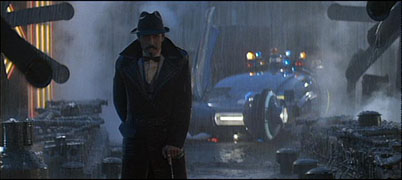 |
 |
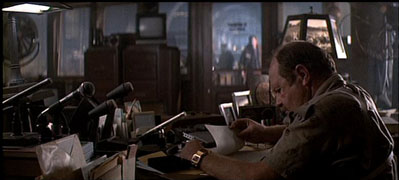 |
|
| |
Matthias Heck
Comment on the role
of the "police" and
authority in the proposal for 2019. Is this appropriately represented
in the architectural setting and technology associated with "authority"?
How does this relate to the portrayal of authority figures in
the two versions of Metropolis as well as Caligari? How might
this play into the uncanny nature of the film?
In Ridley Scott’s futuristic film noir the most important authorities
are obviously corporations like Tyrell, that appear as a strong visual
manifestation by means of giant ads and landmark buildings, and the omnipresent
police forces, represented by the detectives, the (bounty hunter like)
blade runners, their vehicles and the architecture.
Whereas the image of the corporations is characterized by a dark, futuristic
architecture, combined with colourful advertisings on buildings on a
street level, the image of the police is mainly supposed to remind us
of detective film-noir kind of stories. Architecture-wise, the police
station was filmed at Union Station in downtown Los Angeles, mainly because
Scott liked the art deco and neo-Fascist architecture and the immensity
of the location. Furthermore, Bryant’s office at the station looks
like a typical film noir detective or police office, with slow spinning
ceiling fans, the venetian blinds, smoke in the air and old equipment.
The whole office barely contains any high tech devices, though. The noir
theme also influences the style of the involved characters: Holden, Gaff
and Deckard, for instance, are wearing floppy trenchcoats, which is another
typical feature of detectives in classic film noirs.
A main element of the police presence are the airborne vehicles called
spinners, that come sweeping from the dark sky. In most of the scenes
where the upper city levels are shown, we see those spinners flying around
or descending into the depths of the street levels, creating the impression
of an omnipresent police force that controls the airspace – opposed
to the neon-lit, dark, downtown streets that are populated by the lower
class dregs of society. This fact, combined with the arbitrarily and
rough behaviour of the shadowy police characters (finding and terminating
Replicants in public), creates an uncanny feeling about the police force.
In both of the Metropolis movies we have the same layout of how the
city works: the authorities are located at the upper parts of the city,
(Ziggurat), whereas the lower classes of society are living in the lower
districts and zones, a dark and shadowy environment. Once again, it is
the strong contrast that seems striking. Concerning the role of the authorities
in the Blade Runner universe, a quote by Detective Bryant seems insightful,
as it is a good statement to show the social gap between authorities
and the lower classes in the Blade Runner universe: "If you're not
cop, you're little people."
|
|
| |
22. |
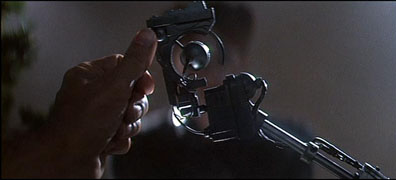 |
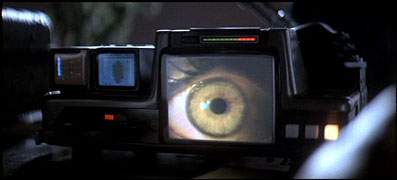 |
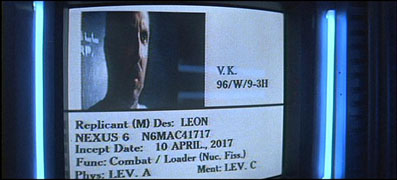 |
|
| |
Lejla Odobasic
If the motto for Tyrell is "more human
than human", and human beings are the most vulnerable in their
expressions of the eye, why would the eye be chosen to be the telltale
sign of a replicant? Is this not a contradiction?
|
|
|
23. |
 |
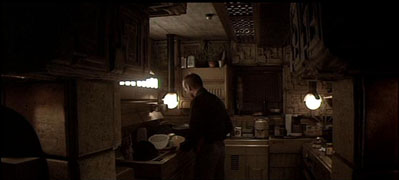 |
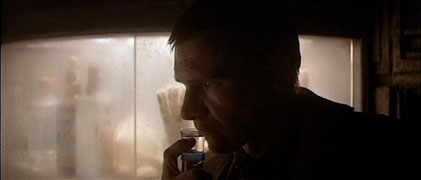 |
|
| |
Suzanne Gibson
There has long been speculation in the
many versions of this film that Deckard is also a replicant. Cite
instances from the film to SUPPORT this claim - use the idea of
the Uncanny Valley in your argument. (note Kate has the opposite
question and I am setting up an oppositional presentation on purpose!)
The opening prologue in Blade Runner informs the viewer
that six replicants made their way to earth, one was killed; as the
movie proceeds the viewer is introduced to 4 replcants who had come
to earth, and one, Rachael, who was made one earth. This begs
the question who is the fifth replicant? There are many hints through
out the film that suggest that Deckard is the unaccounted for replicant. The
main clue is while playing the piano with Rachael, Deckard lost in
thought has a vision of a unicorn galloping through a forest. A unicorn
appears again at the end of the film in the form of an origami unicorn
discard by Graff, a member of the police. As Deckard is leaving his
apartment with Rachael he see the origami unicorn and picks it up,
it is at the moment the viewer is aware that Graff knows what Deckard
is thinking, suggesting that like Rachael who is ‘more human
than human’ his
thoughts and memories have been created for him. Watching the film
a second time with the knowledge that the police know that Deckard
is a replicant, the clues become more obvious. I would like to
argue that Graff is the real blade runner and Deckard does the work
that Graff would not be able to do with his human strengths. To support
this thought, through out the movie Graff seems to follow Deckard,
appearing immediately after the retirement of each of the replicants,
not only does he know what Deckard is thinking by he also knows where
he is. It is always after the dangerous work has been completed that
Graff makes his appearance. To further this notion, in the last conservation
between Graff and Deckard after the four replicants had been killed,
Graff says, “you’ve done a man’s job,
sir! I guess you are through?” Once again reaffirming that
Graff is aware that Deckard is not human.
There
are also many other hints of Deckard’s non-human status,
individually all of these hints don’t point to Deckard being a
replicant but when considered together they can make a strong case. First,
Deckard’s apartment is full of photos; replicants tend to have
a particular attachment to photos as they act as a physical link to a
non-existence past. As Rachael had shown Deckard a photo of her family
to prove their existence, Deckard too has a strong attachment to family
photos displaying them through out his apartment. Another point of interest
is Deckard’s eyes, eyes are the one tell tale sign of a replicant,
in several scenes (including the one in the film capture) Deckard’s
eyes have a yellow – orange glow, common in all the replicants. But
a point even more interesting is that when Rachael tearfully asks if
Deckard had ever taken the Voight-Kampf test, a test involving the eyes
that determines if an individual is human, he avoids the question by
not answering. Not does Deckard avoid answering the question but he also
has super human strength that is also common to replicants, after taking
a sever beating and have 3 fingers dislocated, Deckard still manages
to scale a building, no small feat. Lastly Deckard has a particular empathy
toward the replicants, after their deaths he says to Rachael, ‘all
they wanted were the same answers the rest of us want: Where have I come
from? Where am I going? How long have I got?” Deckard’s
empathy maybe rooted in fact that like the other replants he too has
asked these pointed questions about himself. I don’t feel
that anyone of these traits on there own could prove the Deckard is a
replicant but in combination and with the knowledge that Graff is aware
of Deckard’s thoughts, I think a good case can be made that Deckard
is a replicant.
|
|
|
24. |
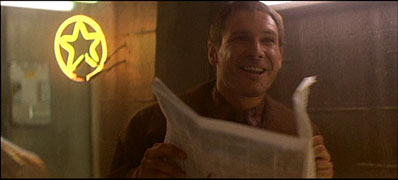 |
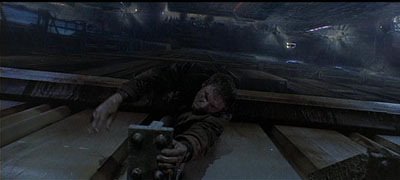 |
 |
|
| |
Kate Gould
There has long been speculation in the many versions
of this film that Deckard is also a replicant. Cite instances from the
film to REFUTE this claim - use the idea of the Uncanny Valley in your
argument. (note Suzanne has the opposite question and I am setting up an
oppositional presentation on purpose!)
In the movie Blade Runner, director Ridley Scott foreshadows our future
where man and robot coexist, with the artificial intelligence advancing
so far that we are virtually indistinguishable in many ways. This
explores the theme of what it means to be human and this fact is exemplified
in the debate about whether or not the protagonist of the film, Deckard,
is himself a replicant.
As a retired blade runner Deckard’s job had been to test replicants
in an empathy test, to see if they exhibit certain emotional reactions
to the questions. The main difference between humans and the
replicants would be revealed in this test. As there are quite
a few releases of the movie, which involved many scene changes, it
is unclear what the director’s original intention was on this
topic. However, in the original theatrical release of the movie,
it can be concluded that Deckard was indeed human.
It is clear that Deckard is human when one views his actions next to
those of the other replicants. The earlier models may appear
human but it is in their inhuman perfection – their endurance,
strength, and lack of emotional weaknesses – that they reveal
themselves to be artificial. In accordance with the uncanny valley
theory, the audience feels revulsion and repulsion towards these characters,
as they so closely resemble humans but exhibit inhuman characteristics. The
only replicant that Deckard could be compared to would be the most
recent model, Rachael. However, there are slight differences
between these two characters which make it clear Deckard is human.
Rachael’s movements, her facial expression and her physical movements,
are always deliberate – never appearing to be controlled by human
emotions. She exhibits no sense of humour, never even cracking
a smile. She exhibits a very cold and formal character, which
appears inhuman.
In contrast, Deckard exhibits many emotions and physical sensations
that the replicants were not able to convey – he exhibits great
personality. In his relations with Rachael he exhibits empathy,
which turns to lust. He seduces her, teaching her to react to
her own emotions. There appears to be a deep connection between
these two characters. As well, another distinctly human characteristic
is the moral conflict that can be seen, which triggers his drinking
to stifle his emotions.
Finally, in the final scenes where Deckard fights the replicant Roy
Batty, he is physically overpowered. Roy breaks Deckard’s
fingers such that he is physically impaired and can’t work the
gun with his right hand. Roy however puts a nail through his
own hand and is still able to fight. Therefore, Deckard couldn’t
be a replicant as he shows human emotions and physical weaknesses.
|
|
| |
|
|
|
|
|
| x |
|
|
|
|
|
